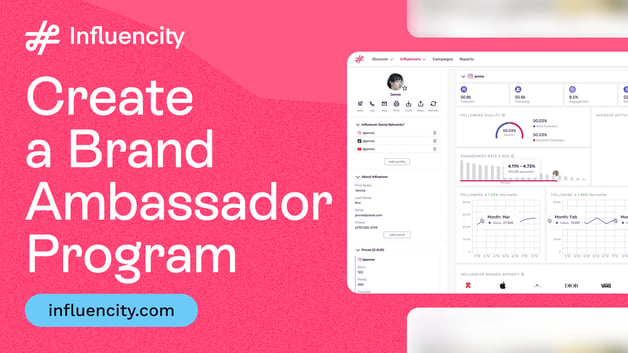Instagram KPIs to You Should Be Tracking in Influencer Marketing
In this article, we are going to discuss why it’s so important to conduct thorough research when you look for an Instagram influencer to work with your brand. We will also explain which Instagram KPIs you need to evaluate to ensure that the influencer you pick is able to meet your expectations and launch a successful campaign for your brand.
What are Instagram KPIs?
Instagram KPIs, or key performance indicators, are specific metrics that measure the effectiveness of your Instagram marketing efforts. These metrics provide insights into how your content is performing, how your audience is responding, and the overall impact of your Instagram presence on your business goals.
Here are some essential Instagram KPIs to track:
- Reach: This measures the total number of unique accounts that have seen an influencer’s content, regardless of whether they have engaged with it.
- Impressions: This measures the total number of times an influencer’s content has been displayed, including multiple views by the same account.
- Engagement Rate: This measures the level of interaction on posts, including likes, comments, and shares, relative to an influencer’s number of followers.
- Follower Growth Rate: This measures the number of new followers you gain over a specific period, reflecting an influencer’s ability to attract and retain an audience for your brand.
- Click-Through Rate (CTR): This calculates the percentage of people who click on a link in your bio or on a call-to-action button.
- Sales Conversion Rate: This measures the percentage of people who take a specific action, such as making a purchase, after seeing an influencer’s content.
- Earned Media Value. Earned Media Value (EMV) is a crucial Instagram KPI that measures the overall value of brand mentions, media coverage, and social interactions generated by influencer marketing campaigns. It goes beyond traditional metrics like reach and impressions to quantify the tangible impact of influencer collaborations on brand awareness, engagement, and ultimately, business outcomes.
- Audience and Likers data. This gives you insight into the users you are reaching with your sponsored content. Audience data refers to the followers who follow and interact with an influencer on a regular basis. Likers, on the other hand, are users who might have come across an influencer’s post on their For You Page and ‘Liked’ a post. While Likers share less of a connection with an influencer, their demographic data can still give you an idea of the users you are reaching.
Why Instagram KPIs Are So Important
Instagram is one of the most effective platforms for influencer marketing campaigns. With millions of active users looking for engaging visual content to inspire them, it can be a great platform for reaching new audiences and building brand awareness. But your campaigns will only be as successful as the influencer you choose to work with, which is why it’s so important to conduct thorough checks before you contact an Instagram influencer.
Instagram KPIs are a great tool for measuring the success of an influencer and identifying how well their past campaigns have performed. These Key Performance Indicators can help you determine an influencer’s reach, their follower growth rate, how much their audience engages with their posts, and how active they are on the platform. You can also calculate the quality of their audience and what their Earned Media Value is, amongst other factors. All this can help you decide whether they are equipped to meet your expectations or whether investing in them is likely to bring you very few rewards.
Specific Benefits of Tracking Instagram KPIs
Here are four specific benefits of tracking Instagram KPIs:
- Identify and optimize content performance. By tracking metrics like engagement rate, reach, and impressions, you can identify which types of content resonate best with your audience. This information can help you create more engaging content that drives better results.
- Understand audience preferences. Analyzing metrics like follower demographics, content preferences, and engagement patterns can provide valuable insights into your target audience's interests, behaviors, and expectations. This allows you to tailor your content and marketing strategy to better connect with your audience.
- Measure campaign effectiveness. Tracking KPIs like click-through rates, conversion rates, and sales generated from Instagram campaigns provides concrete evidence of their success. This data helps you evaluate the effectiveness of your marketing efforts and identify areas for improvement. For example, if you are implementing a hyperlocal social media strategy, tracking Instagram KPIs like impressions in your target area, clicks from your posts to your website, and sales generated from those clicks can help you determine the effectiveness of your reach and engagement efforts.
- Make informed business decisions. By analyzing Instagram KPIs alongside other business metrics, you can gain a holistic understanding of your marketing performance. This information can inform strategic decisions about resource allocation, budget prioritization, and overall marketing goals.
Instagram KPIs You Need to Track Influencer Performance
Whether you’re looking for a celebrity influencer, a nano-influencer, or a niche local influencer for your agency or brand, the process you use for researching them is the same. You need to see beyond their vanity metrics and get down to the essence of what they are actually capable of producing.
But with so many metrics available, which Instagram KPIs should you be focusing on? Which insights will help you determine if an influencer is a good match for your campaigns and worth investing in?
Here’s a rundown of the most relevant Instagram KPIs for measuring the performance of an active influencer.
Reach and Impressions
Reach and impressions are some of the most talked about KPIs when it comes to influencer marketing, so you are probably already familiar with the concept. However, as these terms are often confused, let’s look at what they actually mean.
An influencer’s reach is the number of Instagram followers who could potentially see their content. This includes their direct following and the number of people who might see their campaigns through search results or recommendations. Impressions are the number of times content has been displayed on Instagram, regardless of whether a user has seen and interacted with it. Impressions also don’t consider whether a post has been seen multiple times by the same user. You should therefore focus more on an influencer’s reach as this will give you a clearer picture of how many people might actually see your campaign.
Engagement
Engagement stands as the cornerstone of a successful Instagram strategy. It's the measure of how well a post resonates with your target audience. While having a large follower count is impressive, it's engagement that truly drives impact.
Why engagement matters:
- Reaching a wider audience. Engaging content encourages Instagram's algorithm to prioritize your posts, increasing their visibility to a broader audience beyond your immediate followers.
- Establishing authority. High engagement demonstrates your credibility and relevance within your niche, helping you attract new followers and build brand loyalty.
- Influencing purchase decisions. Engaged followers are more likely to trust your recommendations and consider your brand when making purchasing decisions.
- Strengthening brand-community connection. Meaningful interactions foster a deeper connection with your audience, fostering a sense of community around your brand.
When you evaluate an influencer’s engagement level, don’t focus solely on vanity metrics like audience size or basic engagement metrics such as the number of likes, comments, and shares on their posts. Instead, look at how many interactions they get with their posts in relation to their audience size.
There are two crucial metrics that you can use to calculate this:
- Social Engagement Rate: This percentage indicates the level of interaction with an influencer’s posts relative to their follower count. A high engagement rate indicates a highly engaged audience. Formula: (Likes + Comments + Shares) / Follower Count * 100 = Social Engagement Rate
- Engagements per Follower: This metric measures the average number of interactions per follower per post. This metric provides a more granular view of engagement strength. Formula: (Likes + Comments + Shares) / Follower Count = Engagements per Follower
The main difference between these two engagement metrics is that the social engagement rate is a percentage, whereas engagements per follower is a ratio. Essentially, the latter provides a more granular view of engagement strength by directly comparing interactions to follower counts.
Follower Quality
When you research an influencer it’s just as important to evaluate their audience. You need to be sure that they are genuine and that they are likely to be interested in your brand. The best way to do this is by calculating the quality of their audience.
For example, you can use Influencity’s Follower Quality Metric to calculate this Instagram KPI and work out which influencer has the most relevant and engaged audience for your campaigns. The tool scans an influencer’s audience, identifies accounts that are fake or inactive, and gives you a final score that represents how many real and engaged followers they actually have. That way, you can be sure that an influencer hasn’t falsely inflated their numbers by purchasing fake accounts and bots.
Earned Media Value
Earned Media Value (EMV) is the monetary value given to all the exposure that you gain when you collaborate with an influencer on a post. It takes into account the number of social interactions on an influencer’s posts, including shares, likes, and comments. Think of it as the equivalent advertising value of your campaign. For example, if an influencer’s EMV is $1,000 and you collaborate with them on a post, this publication will generate the equivalent of $1,000 spent on paid advertising on Instagram.
If you’re comparing two Instagram profiles with similar content and interests and one has $1,000 EMV while the other only has $850, the influencer with higher EMV will give you a bigger value for your money.
You can find out more about how to calculate this metric here.
Analyzing Aggregated Influencer KPIs for Effective Campaign Planning
Finally, it’s also important to analyze aggregated influencer KPIs if you are planning on working with a group of influencers on a campaign. This will help you understand how well they are likely to work together and what combined Instagram KPIs they are potentially able to generate.
For example, with Influencity’s platform, you can use the Influencer Relationship Management feature to analyze the aggregated Instagram KPIs of a group of influencers. You can then analyze their combined engagement, EMV, and audience metrics to see the impact they could generate.
In addition, you can also see the percentage of their audience that overlaps – that is, the percentage of followers who they share and are therefore likely to see your content published by various influencers. Influencer campaings with high overlap are great for generating brand awareness, as users are impacted by your content through various types of content. With time, they become familiar with your brand and may start to consider it when they need a solution that you offer.
Access to all these Instagram KPIs can help you make an informed decision about whether a collaborating group of influencers is the right fit for your brand and whether they can meet your campaign performance objectives.
Tags:






















%20and%20How%20Can%20They%20Benefit%20Your%20Brand%20article.jpg?length=628&name=What%20Are%20Key%20Opinion%20Leaders%20(KOL)%20and%20How%20Can%20They%20Benefit%20Your%20Brand%20article.jpg)








